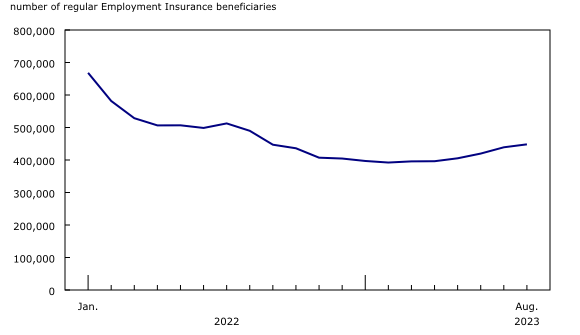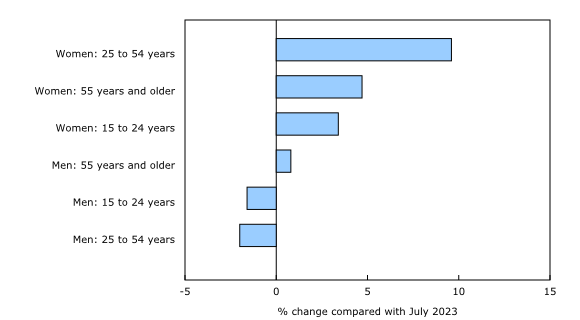Employment Insurance, August 2023
Released: 2023-10-19
There were 448,000 Canadians receiving regular Employment Insurance (EI) benefits in August, up 9,100 (+2.1%) from a month earlier. This was the fourth consecutive increase in the number of regular EI recipients. Despite successive increases, the total number of regular EI beneficiaries in August remained below levels seen in August 2022 (-42,000; -8.5%).
According to the Labour Force Survey (LFS), the unemployment rate was unchanged at 5.5% in August, following three consecutive monthly increases.
In general, variations in the number of beneficiaries can reflect changes in the circumstances of different groups, including those becoming beneficiaries, those going back to work, those exhausting their regular benefits, and those no longer receiving benefits for other reasons.
The number of regular Employment Insurance recipients increases in six provinces
The number of regular EI beneficiaries rose in six provinces in August. British Columbia (+13.4%; +5,700) posted the largest proportional increase, followed by Manitoba (+7.6%; +1,100), Alberta (+5.2%; +2,300), New Brunswick (+5.1%; +1,400), Saskatchewan (+2.3%; +300) and Ontario (+1.7%; +2,100). In contrast, there were fewer regular EI beneficiaries in Quebec (-2.3%; -2,700) and little change in the remaining provinces.
In British Columbia, the number of regular EI recipients rose for the third consecutive month in August (+13.4%; +5,700). This monthly increase was the largest recorded in the province since April 2021. Across Canada, the census metropolitan areas (CMAs) with the largest proportional increases in regular EI recipients in August 2023 were in British Columbia and included Victoria (+18.1%; +400), Abbotsford–Mission (+12.6%; +200) and Vancouver (+12.0%; +2,400).
Following three consecutive monthly increases, Quebec saw a decrease in the number of regular EI recipients (-2.3%; -2,700) in August. This was the first decrease recorded in the province since March 2023. In August, the decline in the number of male regular EI recipients (-7.4%; -5,900) was tempered by an increase among their female counterparts (+8.7%; +3,200). Despite the decline in August, the number of regular EI recipients in Quebec remained higher than in January (+26.6%; +24,000).
More core-aged women, fewer core-aged men receive regular Employment Insurance benefits
In August, the largest increase in the number of regular EI recipients was recorded among core-aged women (aged 25 to 54) (+9,700; +9.6%). Increases among women aged 55 and older (+2,200; +4.7%) and young women aged 15 to 24 (+500; +3.4%) were smaller.
Following three consecutive monthly increases, the number of men collecting regular EI benefits fell in August (-3,300; -1.2%), the first decline since February. The largest month-to-month decline in August was seen among core-aged men (aged 25 to 54) (-3,400; -2.0%), while among young men (aged 15 to 24) the number of regular EI recipients was down by 500 (-1.6%). There was little change in the number of regular EI recipients among older men (aged 55 and older).
The number of regular EI recipients has generally trended up in recent months. Increases have been observed for both men and women, and across all age groups. In August, the number of women receiving regular EI benefits was up by 23,000 (+15.5%) compared with April, while it was up by 29,000 (+11.6%) among men over that same period.
Sustainable Development Goals
On January 1, 2016, the world officially began implementing the 2030 Agenda for Sustainable Development—the United Nations' transformative plan of action that addresses urgent global challenges over the following 15 years. The plan is based on 17 specific sustainable development goals.
Employment Insurance statistics are an example of how Statistics Canada supports reporting on global sustainable development goals. This release will be used to help measure the following goal:

Note to readers
Availability of data by occupation
Statistics Canada is currently revising the Employment Insurance Statistics (EIS) data to conform to the 2021 National Occupational Classification (NOC) standard. This will result in EIS occupation categories aligning with the 2021 Census of Population and Labour Force Survey NOC 2021 categories. The release of revised data is planned for later this year. Until then, information on Employment Insurance (EI) beneficiaries by occupation, including tables 14-10-0336-01 and 14-10-0337-01, will not be available.
Concepts and methodology
EI statistics are produced from administrative data sources provided by Service Canada and Employment and Social Development Canada. These statistics may, from time to time, be affected by changes to the Employment Insurance Act or administrative procedures.
EI statistics indicate the number of people who received EI benefits and should not be confused with Labour Force Survey (LFS) data, which provide estimates of the total number of unemployed people. There is always a certain proportion of unemployed people who do not qualify for benefits. Some unemployed people have not contributed to the program because they have not worked in the past 12 months or their employment was not insured. Other unemployed people have contributed to the program, but do not meet the eligibility criteria, such as workers who left their jobs voluntarily or those who did not accumulate enough hours of work to receive benefits.
All data in this release are seasonally adjusted, unless otherwise specified. To model the effects of the COVID-19 pandemic, values for all series from March 2020 to November 2021 have been treated with a combination of level shifts and outliers to determine a seasonal pattern for seasonal adjustment. For more information on seasonal adjustment, see Seasonally adjusted data – Frequently asked questions.
The number of regular EI beneficiaries for the current month and the previous month is subject to revision.
The number of beneficiaries is all people who received regular EI benefits from August 13 to 19, 2023. This period coincides with the reference week of the LFS.
A census metropolitan area (CMA) and a census agglomeration (CA) are formed by one or more adjacent municipalities centred on a population centre. A CMA must have a total population of at least 100,000. A CA must have a population of at least 10,000. See Standard Geographical Classification 2016 – Definitions for more information.
Next release
Data on EI for September will be released on November 16.
Products
More information about the concepts and use of Employment Insurance statistics is available in the Guide to Employment Insurance Statistics (73-506-G)
Contact information
For more information, or to enquire about the concepts, methods or data quality of this release, contact us (toll-free 1-800-263-1136; 514-283-8300; infostats@statcan.gc.ca) or Media Relations (statcan.mediahotline-ligneinfomedias.statcan@statcan.gc.ca).
- Date modified:




